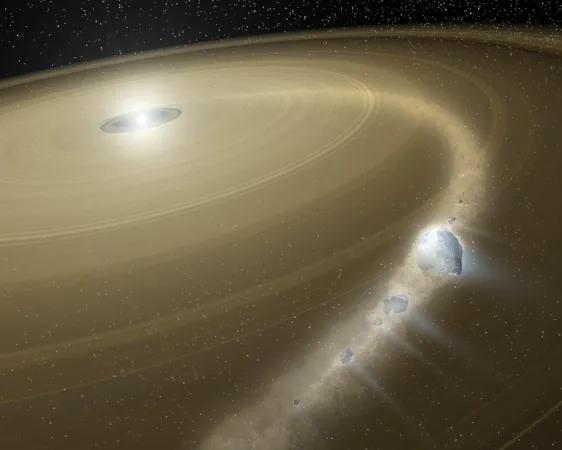
Hubble Uncovers White Dwarf Feasting on Strange Exo-Pluto Fragment!
2025-09-18
Author: Jacques
In a stunning cosmic revelation, researchers using NASA's Hubble Space Telescope have discovered that a white dwarf—a burned-out star—has been munching on a fragment from a Pluto-like object in our stellar neighborhood.
This incredible white dwarf, only half the mass of our sun but compacted into a size comparable to Earth, has been pulling apart ice-rich debris from its own version of the Kuiper Belt, a ring of ancient, icy materials surrounding solar systems. Details of this celestial snack session were unveiled in a report published on September 18 in the *Monthly Notices of the Royal Astronomical Society*.
Through meticulous analysis of the chemical makeup of the doomed object, scientists identified key volatile compounds—those with low boiling points—such as carbon, sulfur, nitrogen, and an intriguing abundance of oxygen, indicating a significant presence of water.
"We were surprised," confessed Snehalata Sahu from the University of Warwick, who spearheaded the data analysis of Hubble's extensive survey of white dwarfs. "We hadn't anticipated finding water and similar icy materials because these celestial bodies typically get ejected from their planetary systems as stars evolve into white dwarfs. Yet, here we are detecting an astonishing amount of volatile-rich remnants."
Thanks to Hubble’s Cosmic Origins Spectrograph, it was revealed that the detected fragments are composed of a staggering 64% water ice. This revelation implies that the object must have originated from far out in the icy recesses of the star system's Kuiper Belt analogue, possibly even larger than typical comets, hinting at the existence of an exo-Pluto!
Notably, the team also found a record-high concentration of nitrogen in this white dwarf's debris, reminiscent of the icy compositions found on Pluto. Sahu remarked, "We believe the white dwarf has consumed fragments from a dwarf planet's crust and mantle."
Detection of these volatile substances is a unique feat for Hubble, as they are nearly invisible in standard optical light. The white dwarf would appear quite ordinary if observed without Hubble's specialized ultraviolet sensitivity.
Located roughly 260 light-years away, this white dwarf is a relatively close cosmic theater for astronomical observation. Previously, when it shined like our sun, it might have hosted its own planets along with a Kuiper Belt equivalent.
Looking billions of years ahead, when our sun transitions into a white dwarf, remnants from our Kuiper Belt will also be pulled in and consumed by this stellar relic. Sahu predicted, "An alien observer gazing at our solar system in the far future could witness a similar scene to what we observe today around this white dwarf."
The research team aims to harness the capabilities of NASA's James Webb Space Telescope to explore the infrared signatures of volatile molecules like water vapor and carbonates associated with this white dwarf's consumption. Such studies could profoundly enhance our understanding of how water and essential elements find their way to rocky planets.
With excitement, Sahu also noted the recent encounter with the interstellar comet 3I/ATLAS, emphasizing its potential mysteries surrounding water content—knowledge that could shed light on planetary formation processes.
Boris Gänsicke, the principal investigator behind the Hubble program, expressed his astonishment at identifying a system closely resembling the cold outer edges of our solar system. "This is not just a discovery; it's a pivotal piece in understanding the building blocks of planets and the evolution of icy bodies in cosmic history."









 Brasil (PT)
Brasil (PT)
 Canada (EN)
Canada (EN)
 Chile (ES)
Chile (ES)
 Česko (CS)
Česko (CS)
 대한민국 (KO)
대한민국 (KO)
 España (ES)
España (ES)
 France (FR)
France (FR)
 Hong Kong (EN)
Hong Kong (EN)
 Italia (IT)
Italia (IT)
 日本 (JA)
日本 (JA)
 Magyarország (HU)
Magyarország (HU)
 Norge (NO)
Norge (NO)
 Polska (PL)
Polska (PL)
 Schweiz (DE)
Schweiz (DE)
 Singapore (EN)
Singapore (EN)
 Sverige (SV)
Sverige (SV)
 Suomi (FI)
Suomi (FI)
 Türkiye (TR)
Türkiye (TR)
 الإمارات العربية المتحدة (AR)
الإمارات العربية المتحدة (AR)